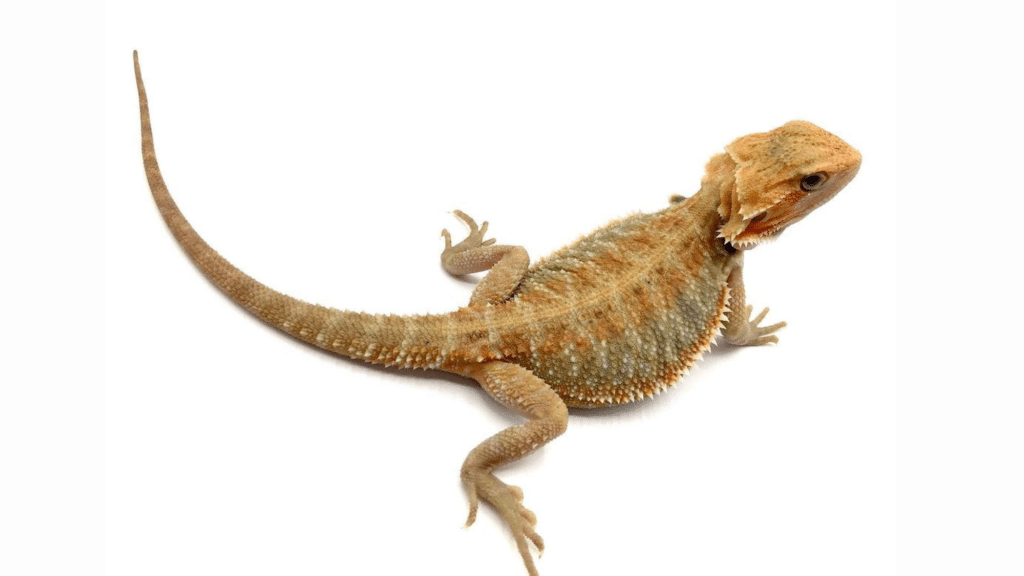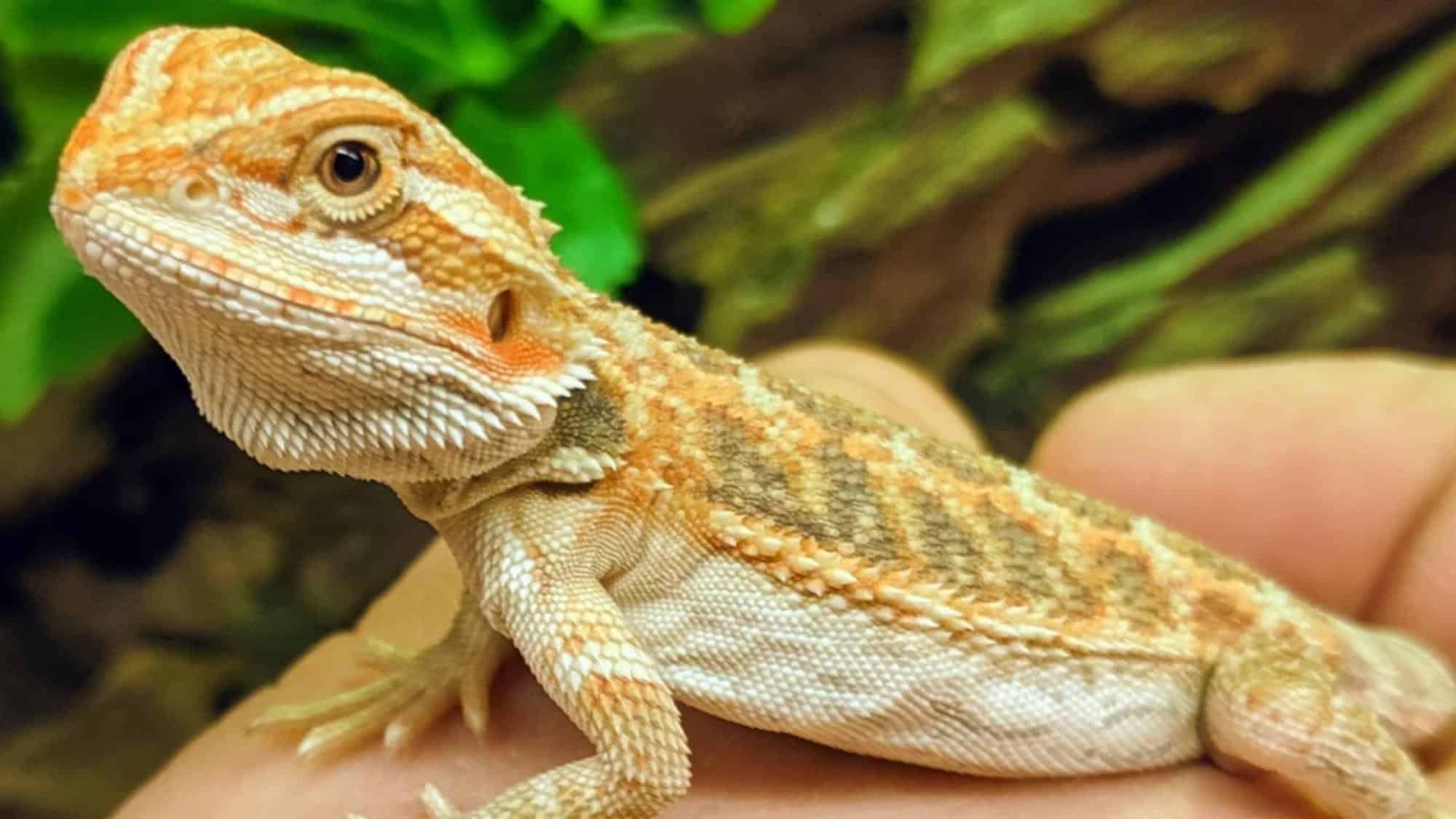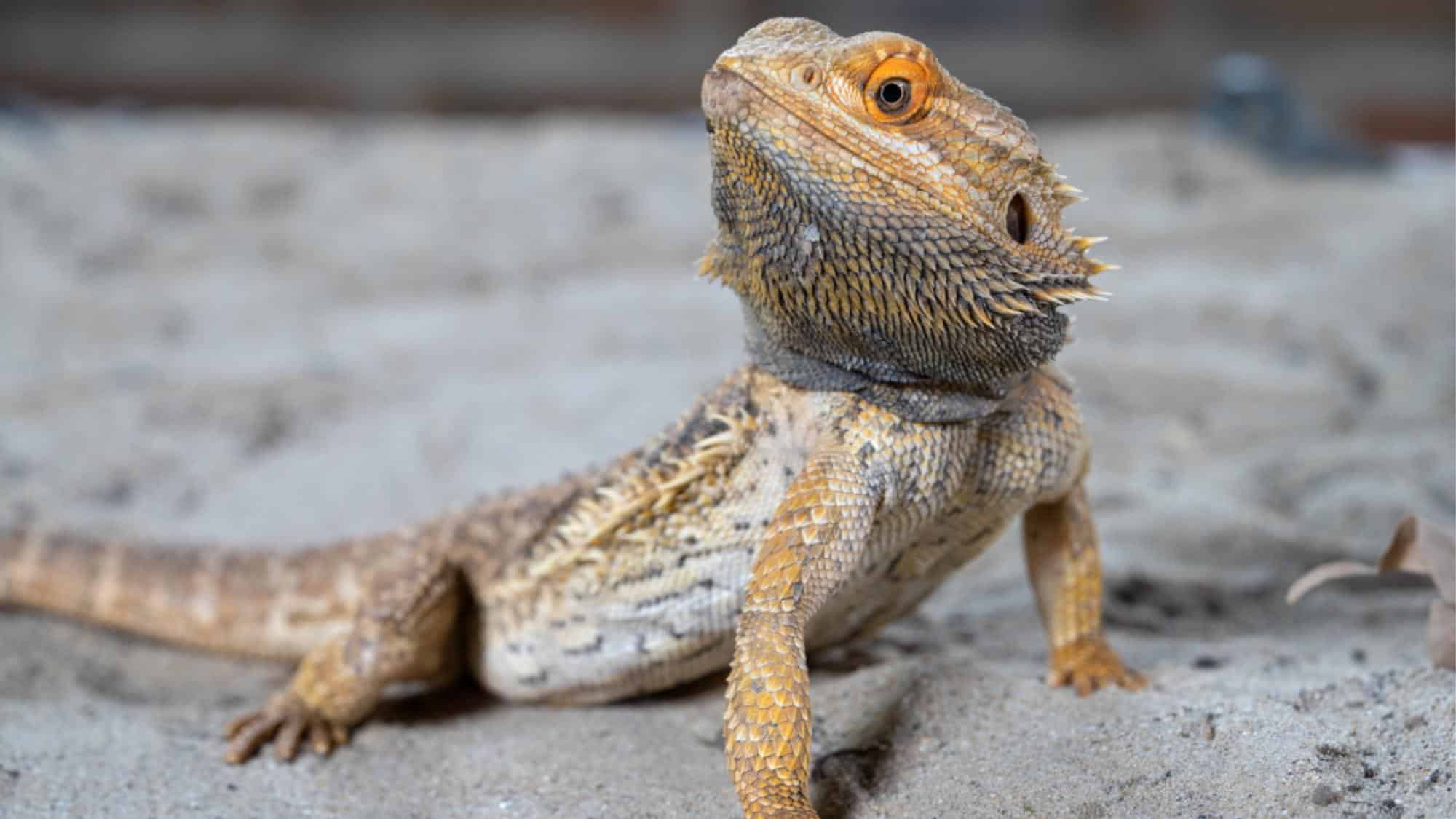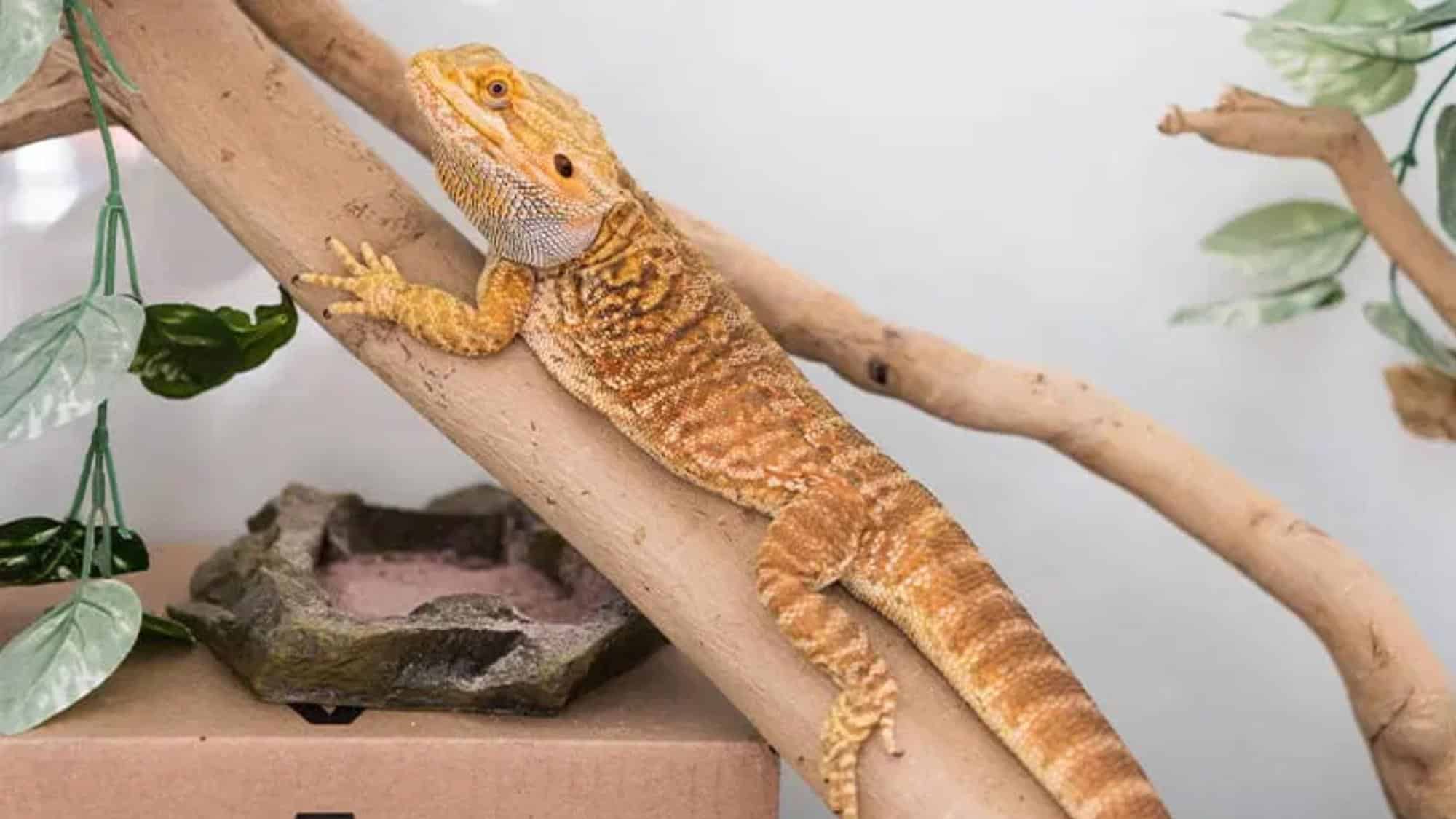Bearded dragons can sleep while standing upright, often pressed against glass or logs like statues. It might look strange, but it helps them feel safe.
These reptiles may act calm, but they have many curious habits that make them fun to watch and learn about.
From how they move to how they react to light and heat, bearded dragons show many smart and funny behaviors.
Whether you already have one or just want to learn more, these facts about bearded dragons will help you see them in a whole new way.
Let’s take a closer look at what makes these lizards more interesting than most people expect
Appearance and Physical Feature Facts
Bearded dragons come in many colors, shapes, and sizes. These facts show what makes their looks special and how their features help them every day.
1. The Amazing Third Eye: Nature’s Predator Detection System
Bearded dragons have a third eye on top of their heads that works differently from their regular eyes.
- The third eye appears as a small gray spot between their regular eyes
- It connects directly to the brain through a special nerve pathway
- This eye helps them notice birds of prey flying overhead
- Wild beardies use this eye to find safe basking spots with overhead cover
2. Remarkable Color-Changing Abilities: Their Natural Mood Ring
Bearded dragons can show off an array of colors that shift throughout the day based on several factors.
Their skin pigment cells react to heat, light, stress levels, and social situations, making them natural mood indicators.
- Morning colors tend to be darker to help them warm up faster
- Stress or fear can cause rapid darkening of their bodies
- Breeding males show brighter colors to attract females
3. Growth Patterns: From Tiny Hatchlings to Full-Sized Adults
Bearded dragons start tiny but grow quickly during their first year of life. These medium-sized lizards reach their full adult size by about 18 months, with some variation based on care and genetics.
- Hatchlings measure only 3-4 inches when they emerge from eggs
- They grow most rapidly during their first 6 months
- Female bearded tdragons end to being slightly smaller than males
4. The Famous Beard: Their Trademark Defense Mechanism
The famous beard gives these lizards their common name and serves as an important tool for communication.
This throat pouch contains special muscles that allow it to expand and change color when needed.
- Both male and female bearded dragons have beards
- The beard turns black when the lizard feels threatened
- Males display their beards during the mating season to attract females
5. Triangular Head Structure: Built for Protection
Bearded dragons have distinctive triangular heads covered with small spikes and scales. Their head shape helps them look fierce to predators while housing powerful jaw muscles.
- The spiky scales offer protection from predator attacks
- Their wide heads provide space for strong jaw muscles
- Young dragons have proportionally larger heads compared to their bodies
6. Jaw Strength: Impressive Eating Machinery
Bearded dragons possess surprisingly strong jaws for their size, allowing them to tackle various foods.
Their teeth and jaw structure let them process both plant material and small prey items efficiently.
- They have small, specialized teeth that continually regrow throughout life
- Their bite force is strong enough to crush insects with hard exoskeletons
- Young beardies have stronger bites relative to their size than adults
7. Male vs Female: Physical Differences Between the Sexes
Male and female bearded dragons show several physical differences that become more obvious as they reach maturity. These differences help owners determine their pet’s gender without special testing.
- Males have more pronounced femoral pores on their back legs and display more dramatic head-bobbing behaviors
- Female dragons typically have smaller heads and narrower bodies and they tend to have shorter and less pointed anal spines
8. Tail Function: More Than Just an Appendage
The tail makes up a significant portion of a bearded dragon’s total length and serves multiple purposes.
These thick, muscular tails store fat reserves and help with balance when running or climbing.
- The tail stores fat that can be used during food shortages
- A healthy tail should be thick at the base and taper gradually
- They cannot drop and regrow tails like some other lizards
Behavior and Communication Facts
Bearded dragons may look calm, but they do many things that are funny, smart, or surprising. Here are some cool behaviors you might not expect.
9. Arm Waving: Complex Social Signaling System
Bearded dragons use arm waving as a form of non-verbal communication with other lizards.
This gentle, circular motion serves as a peace offering or acknowledgment when they meet other dragons.
- Females wave more often than males, especially during the breeding season
- Young beardies wave to show submission to larger or more dominant dragons
10. Head Bobbing: The Language of Dominance and Territory
Bearded dragons communicate status and intentions through distinct head bobbing patterns. This up-and-down motion varies in speed and intensity depending on what message they want to send.
- Rapid head bobs typically signal dominance or territorial warnings
- Slower, gentler bobs may be used during courtship displays
- Males bob more aggressively than females in most situations
11. Body Flattening: Dual-Purpose Physical Adaptation
Bearded dragons flatten their bodies horizontally for two very different reasons. This behavior helps them control their temperature and serves as an important defense mechanism.
- A flattened body provides more surface area to catch sun’s rays
- When threatened, flattening makes them appear bigger to predators
- The degree of flattening can indicate their level of concern
12. Bipedal Running: Their Surprising Speed Mechanism
Bearded dragons can suddenly sprint on their hind legs when they need a quick escape. This unusual running style helps them move faster and travel through rough terrain more effectively.
- They can reach speeds up to 9 miles per hour on their hind legs
- This behavior is more common in younger dragons with lighter bodies
- The tail provides crucial balance during bipedal running
13. Eye Closing: Signs of Trust and Comfort
When a bearded dragon closes its eyes during handling, it shows a remarkable level of trust. This behavior indicates that it feels safe and comfortable in your presence.
- Eye closing only happens when they feel completely secure
- This behavior takes time to develop in newly adopted beardies
- Wild bearded dragons rarely display this behavior with humans
14. Leaning Behavior: Their Version of Cuddles
Bearded dragons show affection through subtle physical contact, like leaning against their owners. This behavior demonstrates trust and a desire for warmth and connection.
- They often lean toward their favorite person when given a choice
- The pressure of their lean can indicate their level of comfort
15. Owner Recognition: Their Surprising Social Intelligence
Bearded dragons can distinguish their owners from strangers through sight, sound, and smell.
This recognition ability shows that their cognitive skills are more advanced than many people realize.
- They may become more active when they see their regular caretaker
- Some beardies respond differently to their owner’s voice
- They can learn to associate their name with positive experiences
Habitat and Lifestyle Facts
Where do they live and what kind of space do they like? These facts explain what kind of environment helps bearded dragons feel safe and happy.
16. Australian Origins: Their Natural Desert Homeland
Bearded dragons come from the harsh, dry regions of central Australia, where resources are scarce.
These tough conditions shaped their adaptable nature and resourceful survival skills.
- They’re native to woodlands, scrublands, and desert regions
- Different bearded dragon species inhabit different parts of Australia
- Export of wild bearded dragons from Australia is now prohibited
17. Basking Behavior: Their Daily Sun Ritual
Bearded dragons spend hours each day soaking up heat from the sun or warm surfaces.
This essential behavior helps them regulate their body temperature and digest food properly.
- They often flatten their bodies to maximize heat absorption
- Morning basking helps jump-start their metabolism
- In captivity, heat lamps replace natural sunlight for this purpose
18. Daytime Activity: Their Sun-Loving Schedule
Bearded dragons are diurnal creatures, meaning they’re active during daylight hours.
Their daily routine revolves around the sun’s movement across the sky.
- They’re most active during mid-morning and late afternoon
- They often take short rest periods during the hottest part of the day
- Their eyesight is adapted for daylight hunting and movement
19. Lifespan: Long-Term Pet Commitment
With proper care, bearded dragons can be companions for over a decade.
Their relatively long lifespan compared to other small pets makes them a serious commitment.
- Wild beardies typically live 5-8 years due to predators and harsh conditions
- Females may have shorter lifespans due to the stress of egg production
- Proper diet and habitat setup are crucial for maximizing lifespan
20. Burrowing Habits: Their Natural Cooling System
Wild bearded dragons dig underground burrows to escape extreme heat and hide from predators.
This instinctive behavior helps them survive the harsh conditions of their native habitat.
- Their strong claws are perfectly designed for digging in hard soil
- Burrows can be up to 3 feet deep in the wild
- They may share burrows with other bearded dragons
Diet and Eating Habits
Want to know what do Bearded Dragons eat, and how much do they eat? Let’s discuss below.
21. Omnivorous Diet: Plant and Animal Balance
Bearded dragons eat a varied diet that includes both plant matter and small prey animals. This dietary flexibility helped them survive in harsh desert environments.
- In the wild, they eat over 200 different types of plants and animals
- Their diet changes naturally with the seasons based on availability
- Captive beardies need carefully balanced diets to stay healthy
- Their food preferences can vary between individuals
22. Age-Related Diet Shifts: Growing Up Changes Appetite
Young bearded dragons need more protein for rapid growth, while adults require more plants. This natural shift reflects their changing nutritional needs throughout life.
- Baby dragons eat approximately 80% insects and 20% plants
- Adult dragons typically eat 80% plants and 20% insects
- The shift happens gradually between 8-18 months of age
23. Unique Feeding Mechanism: Tearing Instead of Chewing
Bearded dragons don’t chew their food in the traditional sense. Instead, they use their strong jaws to tear food into smaller pieces before swallowing.
- They have small, triangular teeth designed for gripping rather than grinding
- Food is often swallowed in surprisingly large chunks
- This feeding style is faster and more efficient for desert hunters
24. UVB Dependence: Sunshine for Survival
Bearded dragons require UVB light to metabolize calcium and maintain healthy bones properly. This special light requirement reflects their evolution in the sunny Australian outback.
- Without UVB, they develop metabolic bone disease even with calcium supplements
- They can detect UV light differently from humans
- Wild beardies bask in natural sunlight to get their UVB
25. Brumation Fasting: Their Winter Sleep Mode
Bearded dragons can go weeks or months without eating during brumation, their version of hibernation. This natural cycle helps them survive seasonal changes in their native habitat.
- Their metabolism slows dramatically during this period
- Body fat reserves sustain them through long fasting periods
- Not all pet beardies brumate, especially if kept at constant temperatures
Reproduction and Growth
From tiny eggs to full-grown adults, bearded dragons go through big changes. These facts explain how they grow, change, and start new life cycles.
26. Sperm Storage: Reproductive Time Capsules
Female bearded dragons have the remarkable ability to store sperm for extended periods after mating. This adaptation allows them to produce fertile eggs when conditions are most favorable.
- They can store viable sperm for up to 1-2 months
- This ability helps wild females time egg-laying with optimal weather
- A single mating can result in multiple clutches of fertile eggs
27. Egg Production: Impressive Reproductive Capacity
Bearded dragons lay relatively large clutches of eggs compared to their body size. This reproductive strategy helps ensure the survival of their offspring in harsh desert conditions.
- Females can lay up to 4 clutches per year
- Each egg is about the size of a small grape
- Females may eat less while developing eggs inside their bodies
28. Temperature-Dependent Sex Determination: Nature’s Thermostat
Unlike mammals, the sex of baby bearded dragons isn’t determined solely by genetics.
Instead, the temperature during incubation plays a crucial role in deciding whether eggs develop into males or females.
- Eggs incubated at 93-95°F tend to produce more males
- Eggs incubated at 80-85°F tend to produce more females
- Middle temperatures produce a mix of both sexes
29. Incubation Period: The Long Wait for Hatching
Bearded dragon eggs require a lengthy incubation period before the babies are ready to hatch. This extended development time allows the young to fully develop before facing the outside world.
- The exact incubation time varies based on temperature
- Eggs in the same clutch often hatch within 24 hours of each other
- Babies use a special tooth called an egg tooth to break the shell
30. Sibling Recognition: Family Ties Among Hatchlings
Baby bearded dragons can recognize siblings from their clutch, showing surprising social cognition. This ability helps them form small groups for better survival in the wild.
- Siblings may bask together more often than with unrelated dragons
- They show less aggressive behavior toward siblings
- This recognition may persist for several months after hatching
More Unique Facts About Bearded Dragons
Some facts are just fun to know. These extra bits might make you smile or help you see bearded dragons in a brand new way.
31. Swimming Abilities: Desert Lizards in Water
Bearded dragons can swim when necessary, despite coming from arid environments. This unexpected skill provides them with an emergency escape option when needed.
- They use a side-to-side motion similar to crocodiles when swimming
- Most prefer to keep their heads above water while swimming
- Swimming is an instinctive ability that they don’t need to learn
32. Memory Capabilities: Smart Little Problem Solvers
Bearded dragons possess impressive memory and learning abilities for reptiles. Their problem-solving skills help them find food and go through their environment effectively.
- They can remember the location of food sources for months
- Some can learn to come when called by their names
- These skills help them survive in the challenging desert environment
33. Name Origins: The Story Behind “Pogona”
The scientific name for bearded dragons reveals interesting aspects of their biology. The name Pogona reflects their most distinctive physical feature.
- “Pogona” comes from the Greek “pogon,” meaning “beard.”
- There are eight recognized species in the Pogona genus
- The most common pet species is Pogona vitticeps (Central Bearded Dragon)
34. Play Behavior: Unexpected Reptile Entertainment
Some bearded dragons engage in what appears to be play behavior, which is unusual for reptiles. This suggests higher cognitive function than previously thought.
- They may chase moving objects that aren’t food
- Some show a preference for certain toys or objects
- Play behavior is more common in well-socialized pet beardies
Bearded dragons are full of surprises once you take a closer look.
Whether you own one or just enjoy learning, these facts show how special and fun these reptiles really are.
There’s always more to learn if you keep watching and stay curious.

























